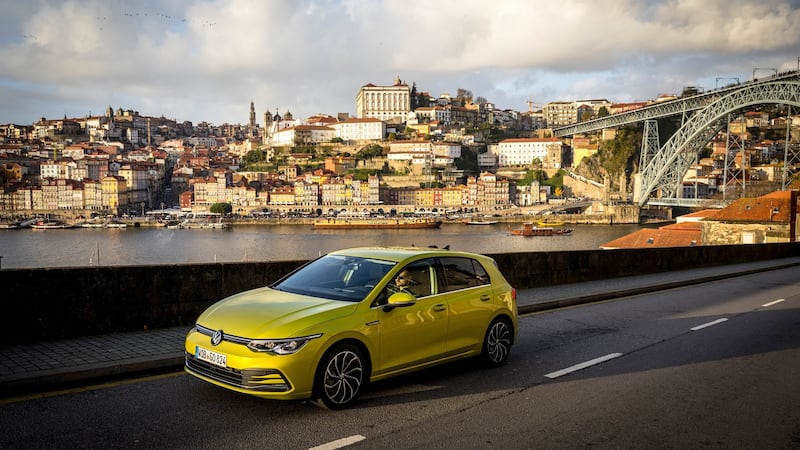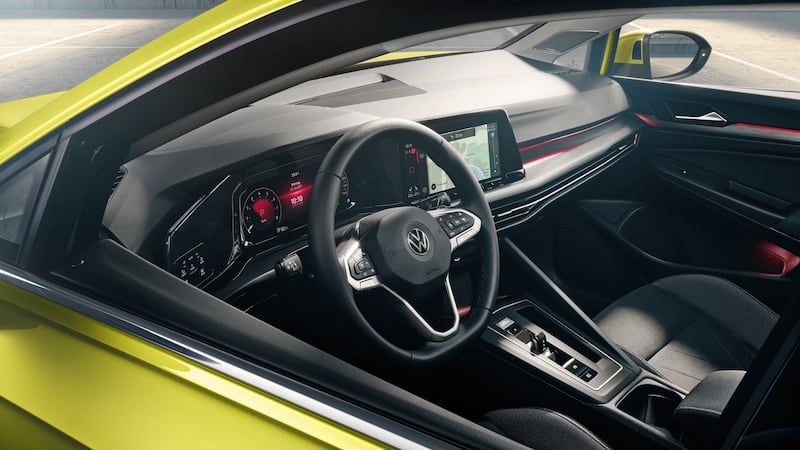As it prepares to write a new chapter in its history, the self-proclaimed “people’s car” brand finds itself in a bit of pickle with its quintessential car. On the one hand the Volkswagen Golf is matched only by the Beetle when it comes to a model that represents the brand. On the other hand, its star seems to be on the wane.
A victim of the crossover craze, it is now being outsold in several markets, including Ireland, by the Tiguan SUV. And next year sees the arrival of arguably the most important Volkswagen in decades: the all-electric ID.3.
If the ID.3 represents the future of the brand, that narrative immediately casts the Golf as the car of Christmases past.

Recasting the role of the the one-time symbol of VW behemoth matters, particularly when it comes to assigning engineering expertise, budget spend and new innovations.
This eighth generation Golf is being billed as all-new, but in reality it comprises several evolutions from the impressive outgoing seventh generation. That’s particularly the case under the outer skin.
Premium styling
In design terms, the look is very much that of the Golf. The reworking of the bonnet and grille adds more premium styling to the car, but in silhouette and at the rear , there’s no question about its lineage.
Inside there’s been a more radical overhaul. Clearly engineers were told to embrace the digital age and seemingly went on a spending spree at the local electronics supplier.
What you have now as standard is a high mounted touchscreen atop the central console and a separate digital screen for the driver. All very high tech, but both screens are bordered by thick shiny plastic that makes them look like the sort of toystore electronics you pick up in Smyths rather than something you'd see in an Apple store. For a car that has long been able to pitch itself as a quasi-premium model in it's own right, it's a bit of a let down.
That sense of disappointment is further stoked by the continued failure to allow simple tasks like volume control or temperature, to be adjusted using a common-sense centrally mounted control knob. Instead they’ve opted for fiddly electronic slider system that’s imprecise and often awkward to use. Somewhere in the eagerness to appear to be embracing new tech, some practical ergonomics have been sacrificed.
Another slider option is at the root of our biggest issue with the new Golf. This particular digital interface controls the steering feel of the car. For some reason Volkswagen has opted to make the steering feel incredibly light, particularly in comfort mode. At times, in the most extreme comfort setting, it has all the feel and feedback of a 1980s arcade game.
And while the new system allows you to chose between a variety of modes - eco, comfort, sport or even individual – even at its most “sporty” setting the steering feel never feels well weighted or engaged in any direct relationship with the front wheels.
It’s a bizarre move by those tasked with creating this new car, and one that was only underlined during our test drives when we got the chance to drive the new Golf back-to-back with the current model.
True, the revised chassis is marginally better than at present, capable of taking a tighter line through the bends and with a little less bodyroll, thanks largely to a more intuitive central control system, but then these weren’t exactly issues with the impressive current iteration of the Golf. This, after all, is the version of the Golf that won the prestigious European car of the year in 2013, and rightly so.
Engine options
While VW is eager to allude to the this eighth generation as “the all-new Golf”, what it really needed to do was make the current great Golf a little better and throw in just a touch more tech. What they’ve done is try to reinvent the recipe, over-egged the tech, messed around too much with the steering feel, and in doing so they’ve lost some of the flavour that made has made the Golf so good.
That said, the engine options are still at the top of their game, with an initial choice of 1.5-litre 150bhp petrol or 2-litre 150bhp diesel. There’s also a mild hybrid version of the 1.5-litre, supported by a 48-volt battery pack, but despite promises of marginally better fuel economy (no official fuel consumption figures are available), an initial test didn’t seem to make enough difference to justify the expected €2,500 extra in price over the regular 1.5-litre 150bhp petrol.

Of the engines we tested, the 2-litre diesel was the most refined and even the steering felt slightly sharper in this variant.
Early next year, VW will add a 1-litre option to the range along with a 130bhp version of the 1.5-litre petrol and an 115bhp version of the 2-litre diesel. An important addition to the range – a plug-in hybrid version with a 13kWh battery matched with a 1.4-litre 125bhp petrol engine and capable of 50km on full electric mode – will land in Ireland next summer.
Opt for the impressive seven-speed dual-clutch automatic transmission and you forgo a gear stick in favour of a little stubby switch, similar to the styling you get for electric cars. If you do need to engage in the business of changing gear, that’s done via steering-wheel-mounted paddles.
And while they have over-egged the tech controls in the cabin, some new features on offer are certainly up to speed with rivals. As with other VW models these days, there are remote software upgrades available, while VW is also rolling out a new car-to-car system known as Car2X.
Hybrid version
This system gathers information from a radius of 800m around the car – in addition to signals from the local traffic infrastructure – and forwards any warnings of hazards ahead to other cars in its vicinity fitted with the system. In time, as more VWs with Car2X take to the roads and it reaches a critical mass of users, this safety alert system should prove very useful.
Irish pricing is not complete as yet, but the new generation Golf will start at €24,500 for the 1-litre 90bhp version when it arrives, while the 1.5-litre starts at €31,000 in the better equipped Style specification. The mild hybrid version of this car starts at €33,500. The 150bhp diesel versions, in Style specification, are expected to start at about €35,000.
These prices mean the new Golf will be pitting itself directly against the all-electric ID.3, starting at under €30,000 for a version with a 330km range between charges.
And there's the rub. This car's main rival will not be likes of the Ford Focus or Toyota Corolla. The biggest threat is from within the family. And the impression you get from the latest Golf is that the competition for finite engineering resources and budget is already starting to show.
For the first time, there’s a sense, perhaps, that it’s slipped slightly down the pecking order of importance at VW. And up against the ID.3 – a car that VW executives simply can’t allow to fail – it’s starting to look like the Golf will be playing second fiddle for the foreseeable future.





















